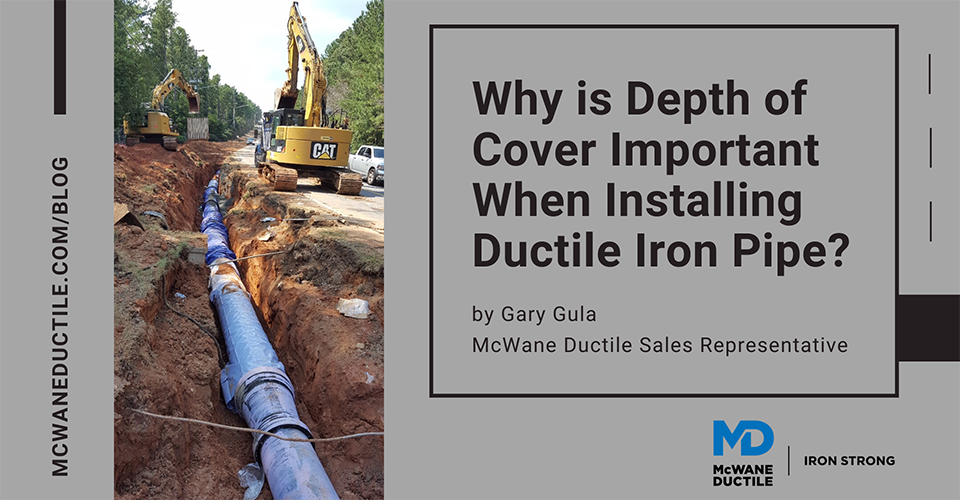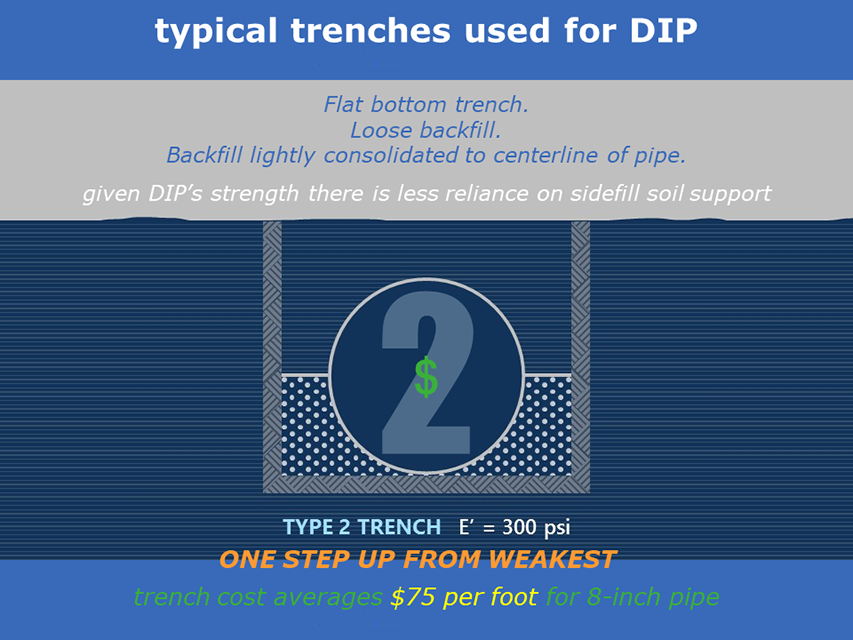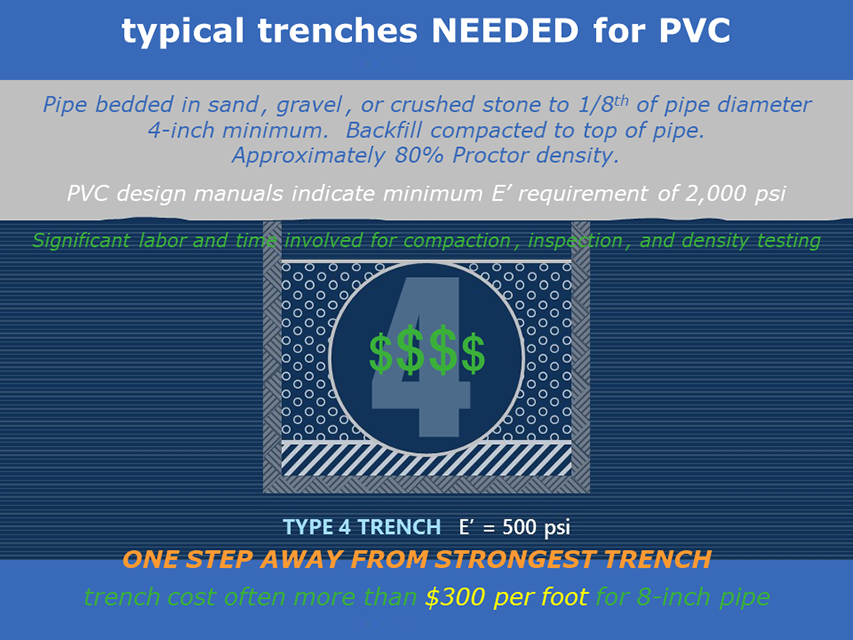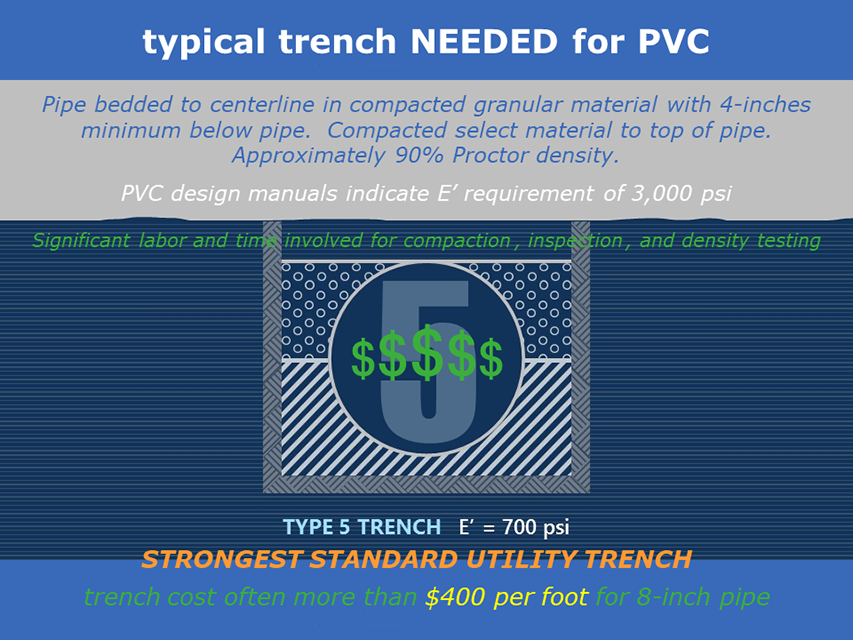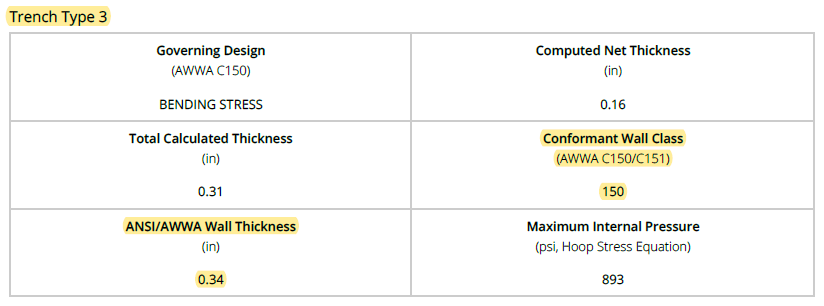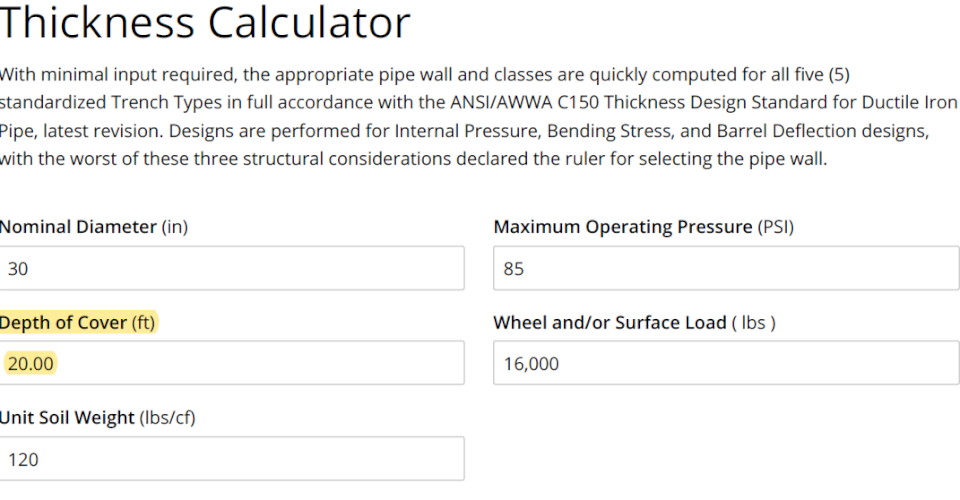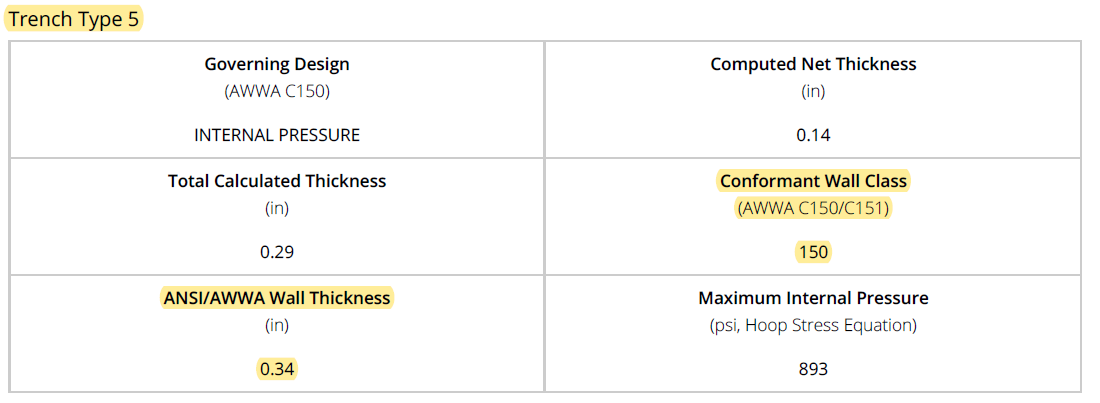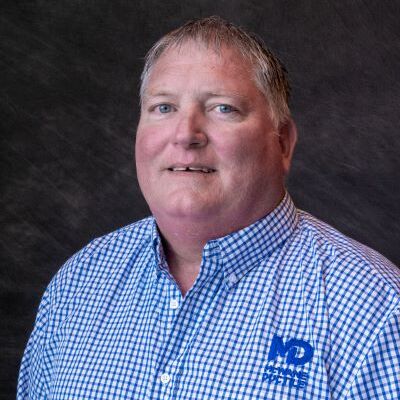Within this article, we will discuss Depth of Cover and the key factors to consider when selecting the type of trench (or laying condition) for your application. We’ll also discuss why it is important to choose the correct trench application, not only for today, but for future adjustments or improvements that are planned for the surrounding area where the pipeline is being installed.
What is Depth of Cover?
In the simplest terms, depth of cover refers to how deep the pipeline will be installed, or how much earth and backfill (typically in feet) will be placed on top of the pipeline to restore the surrounding land to its original, or newly projected elevation.
Ductile iron pipe is very conservatively designed, meaning it is typically a stronger product than the actual rating that the pipe may indicate. This is an “added benefit,” so to speak, in choosing Ductile iron pipe. But selection of the pipe to be installed should still follow the design criteria for the specific diameter and wall thickness of the pipe being installed.
Some variables that often come into play when selecting the required wall thickness of the pipe are:
- Depth of Cover
- Trench Type
- Wheel and Surface Loads (lbs.)
- Internal Pressure
Because of its durability and strength, in almost all cases, Ductile iron pipe requires a much thinner wall thickness, very little depth of cover, and a less stringent trench type requirement compared to alternate materials. We suggest visiting the Calculators tab within the McWane Pocket Engineer app for more details on exactly which pipe meets the specific needs for your application.
Why is depth of cover so important in relation to selecting the correct wall thickness for the Ductile iron pipe in your application?
As mentioned above, the general design of Ductile iron pipe is very conservative, which essentially allows for very little earth to be placed on the pipe while still performing without failure.
That said, the deeper the pipeline is installed, the more weight and external load forces that will be applied to the outer wall of the pipe due to the weight of the soil. The shallower the pipe is installed, the more it will be exposed to potential damage due to the traffic conditions above the installation. In most cases, selecting the correct wall thickness and trench type for the application should be sufficient to overcome these.
A depth of cover that is less than 2.5 feet is generally not recommended due to the potential damage that can occur to the pipe, and/or the pavement above it. Depending on depth of cover, and/or the surface load, it is very possible that a thicker wall or more stringent trench type may be needed to prevent the pipeline from failing as a result of the external loads that it may experience once in service.
Examples of external loads and forces can include:
- the weight of the backfill
- motorized traffic (pipelines under heavily traveled roadways, railroads, etc.)
- buildings and structures
- or other unique scenarios related to the specific application and laying condition.
In conjunction with selecting the correct pipe wall thickness for the depth of the buried pipeline, we will also look at selecting the correct trench type for the pipeline. We’ll also discuss trench types and what their role is in the proper installation of ductile iron pipe later in this blog.
When examining what is called the surface load factor, a calculation is performed to predict how the wheel load (the weight of an object, typically a vehicle) at the surface is transmitted and distributed through the soil to the pipeline.
Without getting into the complex details of the equation, it essentially predicts how the weight of the load will be distributed over a 3-foot section of the buried pipeline.
Various parts of the equation take these factors into account:
- depth of cover (ft.)
- outside radius of the pipe (ft.)
- vertical stress (psi)
- point load at surface (lbs.)
- depth in inches
- distance from the point load.
The diagram below is a good visual aide to show exactly what the equation is calculating.
In conclusion of this section, it is important to select the proper wall thickness for the pipeline -- a wall thickness that can withstand both the depth that it is being buried at and the external wheel (or surface loads) that it will be subjected to once installed.
You can easily see which wall thickness is required for your specific depth of cover (along with the required Trench Type) by entering a few variables within the McWane PE Thickness Calculator.
What are trench types and how do they relate to the proper selection and installation of Ductile iron pipe?
Trench types are standardized descriptions of how the trench where the pipe will be laid is constructed. There are five types of trenches as described below.
Type 1
A typical Type 1 trench is a flat-bottom trench, loose backfill. “Flat-bottom” is defined as undisturbed earth.
- For 14-inch and larger pipe, consideration should be given to the use of laying conditions other than Type 1
Type 2
A typical Type 2 trench is a Flat-bottom trench, backfill lightly consolidated to the centerline of the pipe. “Flat-bottom” is defined as undisturbed earth.
Type 3
A typical Type 3 trench is the pipe bedded in 4 inch (minimum) of loose soil, backfill lightly consolidated to the top of the pipe. “Loose soil” or “select material” is defined as native soil excavated from the trench, free of rocks, foreign materials, and frozen earth. Type 3 trenches are typical in the installation of Ductile iron pipe, as they are most closely related to what you would typically see when digging up and re-using the native earth as backfill material.
Type 4
A typical Type 4 trench is pipe bedded in sand, gravel, or crushed stone to depth of 1/8 pipe diameter, 4 inch (minimum). Backfill compacted to top of pipe. (Approximately 80 percent Standard Proctor, AASHTO T-99)
Type 5
A typical Type 5 trench is pipe bedded in compacted granular material to centerline of pipe. Compacted granular or select material to top of pipe. (Approximately 90 percent Standard Proctor, AASSHTO T-99). “loose soil” or “select material” is defined as native soil excavated from the trench, free of rocks, foreign materials, and frozen earth.
Why is nominal thickness (wall thickness) important?
As a by-product of the inherit strength of Ductile iron pipe, it is very capable of being laid in any of the trench types shown. With the noted exception that 14-inch and larger pipe should only be used in a trench type other than Type 1.
As we have been discussing, you will see in the chart below that the nominal thickness (wall thickness) required for your application will typically increase the deeper the pipe is to be laid. Along with this increase, you will also notice that the maximum depth of cover will also increase as you move from a Type 1 trench up through a Type 5 trench for each respective nominal thickness.
Example:
Using 30” as our example you will see in the chart that it can be installed with a maximum depth of cover of 9 ft using a wall thckness of .34” and a Type 3 trench.
The same 30” (wall thickness .34”) can also be installed with a maximum depth of cover of 22 ft if the trench is constructed as a Type 5.
By upsizing the 30” wall thickness from .34” to .49”, it can be buried at a maximum depth of cover of 19 ft in a Type 3 trench, or 33 ft if being used with a Type 5 trench.
Let’s look at an example of how depth of cover and trench types can factor into your project.
For this example, let’s utilize the McWane Pocket Engineer calculators and look at an installation of 30-inch Ductile iron pipe. For the sake of discussion, we will say the project was designed utilizing CL 150 pipe buried at 4 feet of cover, using a Type 3 trench. As you can see from the chart below, this was the correct selection of wall thickness and trench type for the application.
Under normal circumstances, the selection of 30-inch CL 150 utilizing Trench Type 3 meets all the necessary criteria to be installed and has been designed properly. But what would happen if after manufacturing of the pipe and during construction, it was learned that a future project would actually alter the elevation of the land directly above the installed pipeline and raise it by 16 feet once future roadwork was completed? Essentially, the pipeline that was buried with 4 feet of cover based on today’s assessment would be fine as installed at least until the additional 16 feet of elevation is added to the surrounding area.
The above may or may not be a concern of yours but if you find yourself in this or a similar position, there are some alternatives to explore.
Although it may not be a concern at this time, in the future there lies the potential to require relocation or replacement to meet the new criteria. As you will see in the next chart, when changing the depth of cover from 4 feet to 20 feet (existing 4 feet cover + additional 16 feet cover) it changes the thickness class required and/or the trench type required for the pipe. As we discussed earlier, the deeper the pipeline is laid, the more you will see an increase in the wall thickness required, unless a more stringent trench requirement is utilized.
As seen in the calculated results, there are three options to address this situation if you choose. The options below would incur various expenses and would require negotiations with the engineer of record and owner of the project prior to moving forward.
Option #1 – Replace pipe, use same Type 3 Trench
Once negotiations are complete and a decision made to adjust the current work to accommodate a future adjustment you can replace the CL 150 pipe with CL 53 pipe and continue to use the same trench Type 3.
Although with this option, you need to keep in mind that the replacement pipe will come at a higher cost than the original (due to the thickness required), as well as lost production as you wait on the pipe to be manufactured, delivered, and installed. All of which become issues that need to be negotiated with the engineer of record and owner of the project.
Option #2 – Use CL 150 pipe, use Type 5 Trench
In an effort to accommodate the proposed work to take place in the future you can actually continue to utilize the CL 150 pipe that is onsite but would need to move away from the Type 3 trench and begin installing the pipe in a Type 5 trench.
Again, this option would need to be negotiated with the engineer of record and the owner of the project, but would limit the costs and down time involved if indeed it was decided that the future work needed to be addressed during construction of the current project.
Option #3 – Do nothing
Your final option would be to do nothing. Simply continue installing the pipeline as designed based on today’s assessment of the project. In most cases, you will find yourself only obligated to install a pipeline as designed.
If the engineer of record and owner are aware of potential conflicts that may arise from future work and decide to proceed as planned that is fine as the current installation from our example meets all the requirements for 30-inch CL 150 pipe to be installed at a depth of 4 feet using a Type 3 trench.
Conclusion
Although depth of cover and trench type may not always be thought of as an important factor in installing Ductile iron pipe, they play a vital role in selecting the proper wall thickness for your pipe.
As we wrap up this discussion regarding depth of cover and trench type, we’d like to remind you to please contact your local McWane Ductile representative. We go far beyond just manufacturing Ductile iron pipe and we would be happy to assist with any questions you may have. We also offer on-site classroom or job-site training for you and your crews.
Check out all our digital offerings:

